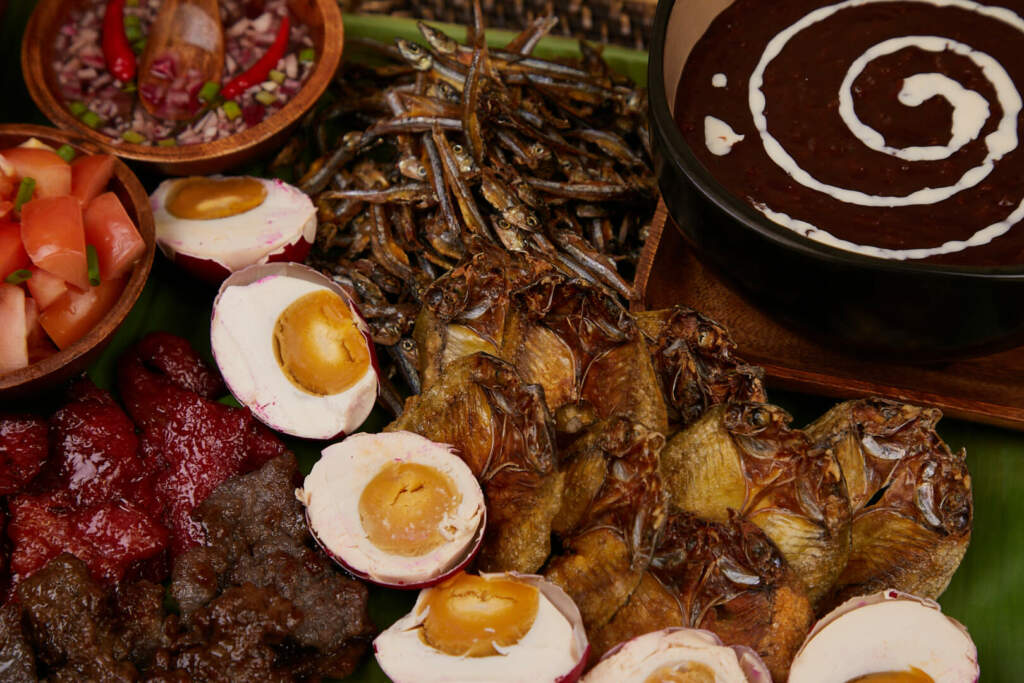Articles
A Paskong Pinoy Breakfast from The Maya Kitchen
What to Serve for a Filipino Christmas Breakfast
The holiday season is here. If you’re looking for a fresh and unique way to celebrate Christmas with your loved ones, then you’ll find it in this article. Here’s an idea. Instead of your usual Noche Buena, why not invite your near and dear to a Paskong Pinoy breakfast at your home? The chefs at the Maya Kitchen compiled a list of tried and tested recipes to transform your ordinary morning meal to a Filipino breakfast celebration.
Simbang Gabi Favorites
Simbang Gabi is an annual tradition for many Filipinos. Waking up in the wee hours of the morning to attend mass for nine consecutive days is a beautiful practice that we inherited from the Spanish. We anticipate the Christmas wish we get to make when we’ve completed the tradition. But more so the warmth of community and the wise sermons given by the priest.
Also, we look forward to eating delicious puto bumbong and bibingka while sipping from steaming cups of tsokolate. These are perfect additions to your Filipino Christmas breakfast menu.
Serve up this all-time favorite with a Western twist: hotcakes. This recipe is good for two to four people. Simply adjust the amount of ingredients based on your guest list. All you need is MAYA Original Fluffy n’ Tasty Hotcake Mix, rice flour, coconut milk, violet gel food coloring, and a few basic ingredients.
Don’t forget to set aside, the main components of the traditional kakanin as toppings: coconut sugar, toasted coconut flakes, and margarine. Take the decadence level up a notch with a dollop of ube jam. In case, you prefer something more traditional, try our recipe for Tsokolate Puto Bumbong.
There’s nothing quite like piping hot bibingka smothered in butter, sugar, and topped with salted egg and grated coconut. Again, this recipe uses MAYA Original Fluffy n’ Tasty Hotcake Mix. It also calls for sliced ham to give this sweet treat a savory spin. This recipe yields eight to 10 servings.
Oh, and don’t forget to use banana leaves. Did you know that aside from being an essential Pinoy cuisine component, it also prevents your food from burning?
Silog Specials
A Christmas breakfast is not Filipino without the silog. This all-in-one meal refers to garlic rice (known as sinangag), a sunny side up egg, and sausage (longganisa) or thin slices of fried cured beef (tapa), and of course, sweet pork belly (tocino). It is then known by the meat used: longsilog, tapsilog, or tocilog.
This is a simple dish that is a staple of any Filipino breakfast. If you’re not Filipino, this may not seem unique. What’s there to making garlic fried rice that’s so special. We’ll let you in on a secret, it has a secret ingredient: fish sauce or patis. Also, day-old cooked rice is usually a better choice. Provided, of course, that it’s not spoiled and stored properly the night before. This is a must-have for your silog meal.
Longganisa is a form of pork sausage that is prepared in a variety of ways, depending on place of origin. For instance, the Vigan variety is an Ilocano favorite that is known for its tart taste that’s redolent of garlic. It uses sugar cane vinegar made in the region. Another example is, Bacolod Chorizo (or Chorizo Negrense), which is native to a province in Negros Occidental. It’s known for its caramelized smoky flavor citrusy tang and owing to that calamansi is an ingredient.
Now, our version is a mix of both worlds: sweet, garlicky, and tangy. Try this longsilog it for yourself, then let us know what you think.
As mentioned, earlier tocino is sweet pork belly. In Spain, it’s remarkably like bacon and cubed. In the Philippines, it’s known for its fatty goodness and pinkish color even after cooked. Our version used pork shoulder or tenderloin. You need to slice the pork into thin strips, gently massage it with sugar and other ingredients. Tocilog would be perfect for your Filipino Christmas breakfast.
Filipino Christmas Breakfast: At Iba Pa
There’s more to a Filipino breakfast than just silogs and kakanin. Here are other foods to serve at your morning feast.
This Filipino bread is a common pantry staple in Filipino households. Often oblong in shape, its name translates to “salt bread” in Spanish. It’s known for its soft crumb, and when toasted, has a crunchy crust that turns a deep brown. It’s usually taken with a cup of coffee and slathered in margarine. It’s also considered merienda fare.
It’s easy to make, but if you’ve never attempted baking bread before, check out these quick reads first:
- Essential Baking Tips for Beginners
- Breadmaking 101
- Common Mistakes When Baking Bread
- Tips When Baking with Yeast
- Beginner Bread Baking Tips
In other parts of the world, rice porridge is an essential part of the morning meal. It’s warm and comforting and eaten when one feels sick. In China, they serve congee, which is eaten plain or with a variety of toppings. In Japan, it’s known as okayu, and sometimes topped with salmon, umeboshi (pickled ume), ginger, and more. In the Philippines, we have arroz caldo, typically seasoned with chicken broth, ginger, garlic, and topped with scallions, toasted garlic flakes, and boiled eggs.
However, the traditional rice porridge served during a Filipino breakfast of champions is unique. Also eaten in Mexico and made from glutinous rice, champorado or tsampurado is generously flavored with dark chocolate. In the Philippines, we eat it with dried herring known as tuyo. While this combination may seem unusual, we assure you its’s a tasty one.
We hope this article helps you host an unforgettable Paskong Pinoy breakfast. Wouldn’t it be wonderful to make one part of your yearly Christmas tradition? Let us know how your goes by leaving a comment below.

